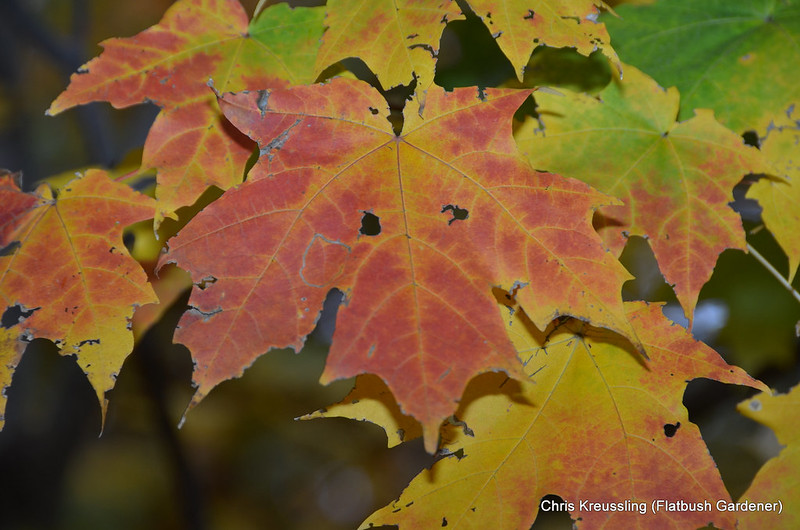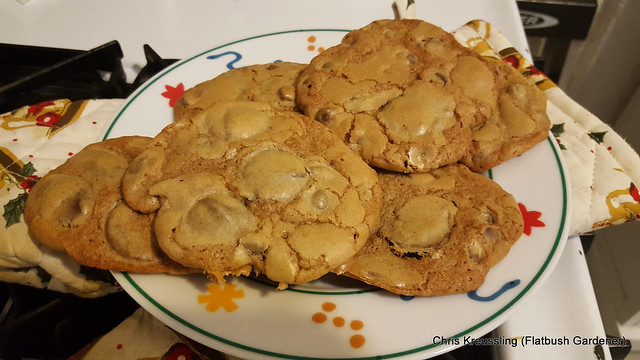Updates 2014-12-13: Simplified the baking temperature and time, and added notes about portion sizing.
Yesterday it was hard for me to do anything. Although the weather was perfect - 60s and partly sunny - for planting the bulbs I have yet to get into the ground, I could not bring myself to go outside. It's only been two weeks since my father died, and I was feeling his absence deeply and sharply yesterday.
When I wrote that "there's so much of him in me," I didn't appreciate how much I would feel a loss of my own self, a void left standing where "the library burned down." It reminds me of the hole in the sky where the twin towers of the World Trade Center once stood. The absence is palpable.
By the end of the day, I was feeling a little better, and I thought that surrendering to my winter baking mode would help. I was prepared to make some basic chocolate chip cookies, but Blog Widow came home with a box of soft, store-bought ones. I experimented with something new, and here's what I came up with:
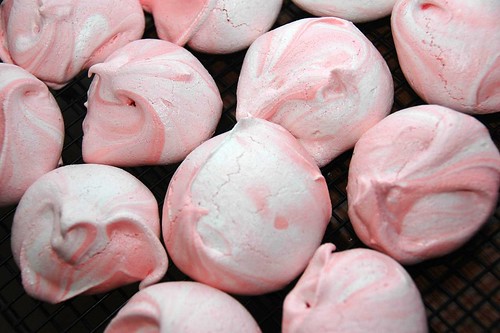
I call these Peppermint Swirl Meringue Cookies, an elaboration of a
basic meringue recipe from King Arthur Flour. KAF is my favorite source for all things baking. I was happy to find that the
Flatbush Food Co-Op carries several varieties of King Arthur Flours in the well-stocked baking section of their new location.
I've made meringues many times before, but Blog Widow has never cared for them. He likens their texture to styrofoam, and I can't disagree. The best way to eat them is not to bite into them. Instead, let them dissolve on the tongue, releasing a burst of the flavoring baked into them.
Part of last night's experiment was to see if I could achieve a texture that would satisfy Blog Widow: crisp and crunchy on the outside, soft and chewy on the inside. The KAF recipe suggested that I could accomplish this simply by baking them for an hour less than usual. This worked beautifully. Here's a single, intact meringue cookie, the same one in the center foreground of the photo above:
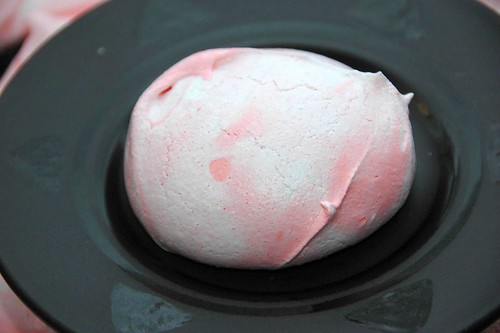
And here's the same cookie broken open (shattered, really!) to show the chewy, slightly gooey, interior:
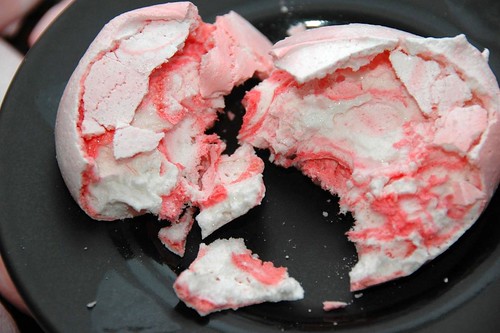
Perfect. And baking these did help lighten my spirit.
Meringues are more confection than cookie. The basic ingredients are just egg whites and sweeteners: no fat and no cholesterol. Since there's no flour, they're also fine for folks avoiding gluten.
I use dried, powdered egg whites in recipes calling for them. It saves the hassle of separating them, and I don't have to figure out what to do with the yolks. However, dried egg whites can have an off, eggy taste. You want to make sure that the flavoring is assertive enough, without being too aggressive, to balance the recipe.
The classic flavoring is vanilla, but anything can be used. I thought I would make some red and green meringues with different flavorings for each color, such as cinnamon for red, lime for green. But a tip in the KAF recipe suggested coloring just half the mixture and swirling them together. White plus red stripes just screams candy cane, so peppermint was the flavor I went with. (If I had spearmint flavoring, I would also try green and white stripes.)
Here's how I made the cookies in these photos, presenting the basic KAF recipe with the slight adaptations I had to make along the way. The basic KAF recipe presents lots of possible variations, even adding nuts to the meringue, so check that out for other creative options.
Ingredients
- Egg whites of 6 large eggs (7/8 cup, or 7-8 ounces), or 1/4 cup dried egg whites dissolved in 3/4 cups water, at room temperature (separate eggs when cold, but whip them at room temperature to get the best volume.)
- 1/4 teaspoon cream of tartar (a mild acid which helps stabilize the whites when beaten)
- 1/4 teaspoon salt (for flavor only. You can omit this if you need to minimize sodium, although the egg whites naturally contain sodium of their own.)
- 1 1/4 cups extra-fine sugar (also known as sanding or castor sugar. I used regular white, refined sugar and they came out fine. A finer grain of sugar dissolves easier in the whites for a smooth, non-gritty texture.)
- 1 1/2 cups (6 1/4 ounces) confectioner's sugar (powdered sugar)
- 1/2 teaspoon peppermint extract
- 1/4 teaspoon vanilla extract (The vanilla mellows and warms the peppermint, which remains the dominant flavor.)
- red food coloring (I used a gel type.)
Preparation
- Preheat the oven to 250F. (Be sure you have an accurate oven thermometer! Temperature is lower than usual for baking - too high, and you'll burn, rather than bake, your meringues - and gets reduced further part-way into the baking time. I had a devil of a time baking in our horrible kitchen until I bought a thermometer and discovered that the oven dial was off by 100F!)
- Prepare the egg whites and set them aside to let them come to room temperature.
- Use the largest baking pans you have, line them with parchment paper, and set them aside. (I could only use two pans in my oven, and had to discard part of my batch because I had no more room for them.)
- Sift the sugars together and set them aside.
Mixing
I used a hand whisk for the slow whisking steps, and a mixer with a whisking attachment for the rest.
- Add the cream of tartar to the room-temperature egg whites, Whisk until the cream of tartar has completely dissolved and the whites are foamy.
- If using salt, add it now and whisk to dissolve that as well.
- Increase the whisking speed until the egg whites have doubled in volume.
- Add half the sugar and whisk until the whites are glossy and start to get stiff.
- Add the remaining sugar and whisk until the whites hold stiff peaks. (Since I didn't have extra-fine sugar, I chickened out here a little and added the sugar a little early so it would dissolve completely. I also didn't whisk completely to the hard peak stage. Just the tips of the peaks folded over, which you can see in the finished cookies.)
- Add the flavorings.
- Remove about 1/3 of the meringue into a separate bowl. Add the coloring and whisk it until it the desired color is evenly distributed.
- Add the colored meringue back into the other bowl on top of the white meringue. Using a spatula, gently fold the two meringues together until they are just striped. It only takes a few folds for this.
Baking
- Drop the striped meringue by the spoonful onto the parchment paper on your baking pans. The meringues will not spread while baking, so they can be placed as close as possible without touching each other.
Use a tablespoon to get 3 dozen big cookies; at this size, though, I usually run out of baking sheet before I run out of batter. Use two teaspoons for more, smaller, cookies; the smaller size can be placed more closely together on the sheet, and uses up all of the batter. The smaller ones are bite-sized and easier to handle.
You can also use a pastry bag, if you have one, for fancier cookies.
- Bake at 250F for 30 minutes.
- After 30 minutes, reduce the heat to 225F and bake for one more hour for chewy cookies, or 2 more hours for crisp-all-the-way-through cookies.
- Turn off the heat, crack open the oven door, and let them cool for 30 minutes.
- Remove them to a wire rack to cool completely.
Simplified baking option for chewy cookies: Instead of the two-stage, two-temperature method, bake at 250F for an hour.
Here's another, close-up view of the finished product.
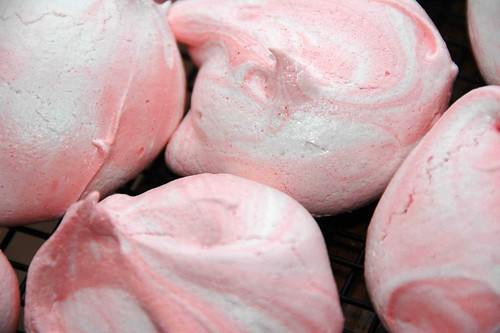
And oh yeah: Blog Widow labels this a successful experiment!
[
http://bit.ly/5R9IxO]
Related Posts
Other recipes on this blog
The quotes in the opening paragraph come from the
eulogy I wrote and read for my father's memorial service on Thursday, December 4, 2008.
Links
Meringues,
Recipes, King Arthur Flour
